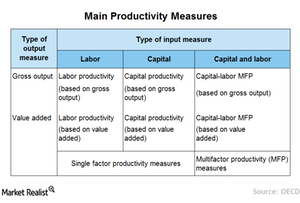What Are the Traditional Measures of Labor Productivity?
Labor productivity is an important tool to measure the strength of a country’s economy. Policymakers often use this indicator to compare output efficiency during a particular period.
Feb. 23 2016, Published 11:11 a.m. ET

Two measures of productivity are commonly used. Labor productivity, or output per hour, is the simpler of the two to construct. To measure output per hour in the nonfarm business sector, one must first measure nominal output, defined as the market value of final goods and services produced in that sector. Then one must deflate the nominal output by the relevant price index to obtain real output. The final step requires dividing the estimate of real output by the number of hours worked in the nonfarm business sector to get per hour output.
Market Realist – Traditional labor productivity measurement metrics
Labor productivity is an important tool to measure the strength of a country’s economy. Policymakers often use this indicator to compare output efficiency during a particular period. An upward movement in labor productivity indicates improvement in the standard of living. Labor productivity also helps compare relative efficiencies of various nations.
The labor productivity ratio measures the efficiency with which inputs are used to produce goods and services. Although the ratio can be measured in several ways, it’s generally measured through metrics such as GDP (gross domestic product), GDP per capita, and TFP (total factor productivity). GDP and GDP per capita capture the overall output of a country from a macroeconomic perspective. On the other hand, TFP, also called multifactor productivity, measures the increase in overall output due to technological (IXN) (VGT) advancement without an increase in inputs.
The most common technique of labor productivity measurement is the output per hour, which measures the volume of goods and services (IYC) produced in a given period by a measure of input used to produce them. The output reflects the nominal value of goods and services produced by the labor force. Although the output is measured either by GDP or GVA (gross value added), they are highly correlated with each other.
The nominal value of output needs to be converted into the real value output, the process known as inflation adjustment (TIP) (STIP). The inflation adjustment process eliminates the effects of general price level changes over time.
